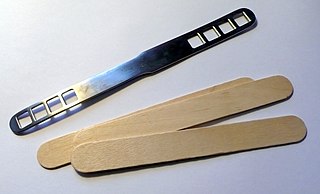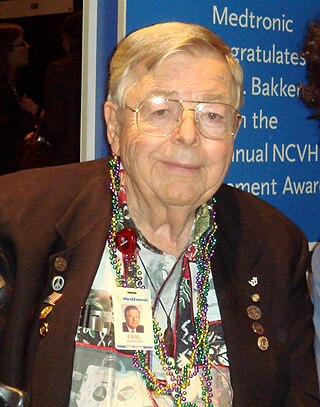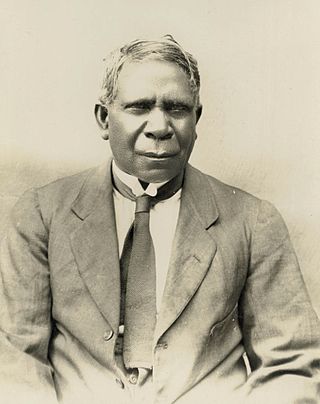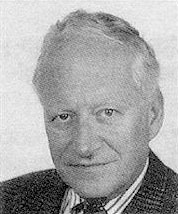Related Research Articles

An artificial cardiac pacemaker is a medical device, nowadays always implanted, that generates electrical pulses delivered by electrodes to the chambers of the heart, either the upper atria or lower ventricles. Each pulse causes the targeted chambers to contract and pump blood, thus regulating the function of the electrical conduction system of the heart.

Defibrillation is a treatment for life-threatening cardiac arrhythmias, specifically ventricular fibrillation (V-Fib) and non-perfusing ventricular tachycardia (V-Tach). A defibrillator delivers a dose of electric current to the heart. Although not fully understood, this process depolarizes a large amount of the heart muscle, ending the arrhythmia. Subsequently, the body's natural pacemaker in the sinoatrial node of the heart is able to re-establish normal sinus rhythm. A heart which is in asystole (flatline) cannot be restarted by a defibrillator, but would be treated by cardiopulmonary resuscitation (CPR).

The contraction of cardiac muscle in all animals is initiated by electrical impulses known as action potentials that in the heart are known as cardiac action potentials. The rate at which these impulses fire controls the rate of cardiac contraction, that is, the heart rate. The cells that create these rhythmic impulses, setting the pace for blood pumping, are called pacemaker cells, and they directly control the heart rate. They make up the cardiac pacemaker, that is, the natural pacemaker of the heart. In most humans, the highest concentration of pacemaker cells is in the sinoatrial (SA) node the natural and primary pacemaker, and the resultant rhythm is a sinus rhythm.

An artificial heart is a device that replaces the heart. Artificial hearts are typically used to bridge the time to heart transplantation, or to permanently replace the heart in the case that a heart transplant is impossible. Although other similar inventions preceded it from the late 1940s, the first artificial heart to be successfully implanted in a human was the Jarvik-7 in 1982, designed by a team including Willem Johan Kolff, William DeVries and Robert Jarvik.
Wilson Greatbatch was an American engineer and pioneering inventor. He held more than 325 patents and was a member of the National Inventors Hall of Fame and a recipient of the Lemelson–MIT Prize and the National Medal of Technology and Innovation (1990).

Artificial ventilation is a means of assisting or stimulating respiration, a metabolic process referring to the overall exchange of gases in the body by pulmonary ventilation, external respiration, and internal respiration. It may take the form of manually providing air for a person who is not breathing or is not making sufficient respiratory effort, or it may be mechanical ventilation involving the use of a mechanical ventilator to move air in and out of the lungs when an individual is unable to breathe on their own, for example during surgery with general anesthesia or when an individual is in a coma or trauma.

A medical device is any device intended to be used for medical purposes. Significant potential for hazards are inherent when using a device for medical purposes and thus medical devices must be proved safe and effective with reasonable assurance before regulating governments allow marketing of the device in their country. As a general rule, as the associated risk of the device increases the amount of testing required to establish safety and efficacy also increases. Further, as associated risk increases the potential benefit to the patient must also increase.

Earl Elmer Bakken was an American engineer, businessman and philanthropist of Dutch and Norwegian American ancestry. He founded Medtronic, where he developed the first external, battery-operated, transistorized, wearable artificial pacemaker in 1957.
Telectronics Pty Ltd was an Australian company best known for its role in developing the pacemaker. It was located in Lane Cove, Sydney. In 1988 the business was acquired by Pacific Dunlop. However, legal claims resulting from the sale of faulty pacemaker electrode leads inherited by the company in acquisition of Cordis Corporation of Miami led to eventual sale of the assets of the company and Pacific Dunlop restructuring itself into Ansell.
John Alexander Hopps, was a co-developer of both the first artificial pacemaker and the first combined pacemaker-defibrillator, and was the founder of the Canadian Medical and Biological Engineering Society (CMBES). He has been called the "Father of biomedical engineering in Canada."
Robert Fischell is a physicist, prolific inventor, and holder of more than 200 U.S. and foreign medical patents. His inventions have led to the creation of several biotechnology companies. He worked at the Johns Hopkins University Applied Physics Laboratory full-time for 25 years and part-time for an additional 13 years. He contributed to APL's satellite navigation work; he later developed a rechargeable implantable pacemaker that could be programmed with radiowaves,. He and his team at Hopkins also helped miniaturize the implantable cardiac defibrillator. Mr. Fischell went on to invent the implantable insulin pump, numerous coronary stents used to open clogged arteries, and two feedback systems that provide early warning of epileptic seizures (NeuroPace) and heart attacks. Fischell recently donated $30 million to the University of Maryland College Park Foundation to establish a bioengineering department and an institute for biomedical devices at the A. James Clark School of Engineering.

Otis Frank Boykin was an American inventor and engineer. His inventions include electrical resistors used in computing, missile guidance, and pacemakers.

Paul Maurice Zoll was a Jewish American cardiologist and one of the pioneers in the development of the artificial cardiac pacemaker and cardiac defibrillator. He graduated from Boston Latin School in 1928.
Babec was a male silverback western lowland gorilla, the youngest of three sons born to Otto and Benga at Chicago's Lincoln Park Zoo. Between 1988 and 1992 he sired 8 offspring, 5 of them with Madge of the Cincinnati Zoo. Six of his offspring survived into maturity, and he has one grandchild, Kiazi Kitamu at the Pittsburgh Zoo. Babec was exhibited at the Birmingham Zoo in Birmingham, Alabama, from 1993 until his death in 2008. He was the only gorilla to have been successfully fitted with a pacemaker, which he wore for four years.

William P. Murphy Jr. is a medical doctor and inventor of medical devices including collaborating on a flexible sealed blood bag used for blood transfusions. He is the son of the American physician William Parry Murphy who shared the Nobel Prize in Physiology for Medicine in 1934, and Harriett Adams, the first licensed female dentist in Massachusetts.

Diaphragm pacing is the rhythmic application of electrical impulses to the diaphragm to provide artificial ventilatory support for respiratory failure or sleep apnea. Historically, this has been accomplished through the electrical stimulation of a phrenic nerve by an implanted receiver/electrode, though today an alternative option of attaching percutaneous wires to the diaphragm exists.
Morton Maimon Mower was an American cardiologist specializing in electrophysiology and the co-inventor of the automatic implantable cardioverter defibrillator. He served in several professional capacities at Sinai Hospital and Cardiac Pacemakers Inc. In 1996, he became the chairman and chief executive officer of Mower Research Associates. He was inducted into the National Inventors Hall of Fame in 2002 for the development of the automatic implantable cardioverter defibrillator with Michel Mirowski in the 1970s. He continued his research in the biomechanical engineering laboratories at Johns Hopkins University.

This is a timeline of Australian inventions consisting of products and technology invented in Australia from pre-European-settlement in 1788 to the present. The inventions are listed in chronological order based on the date of their introduction.

Jozef Cywinski is a Polish-American scientist, a specialist in the field of biomedical engineering and specifically in electrical stimulation of living organisms. His work has been the subject of 12 patents, two books and over 100 scientific publications. He developed several first-on-the-market electro-medical devices like cardiac stimulators pacemakers, train-of-four nerve stimulators, PACS, EMS, TENS and Veinoplus calf pump stimulators.
Mark Cowley Lidwill (1878-1969) was a medical pioneer in anaesthesiology and cardiology. Supported by physicist Edgar H. Booth, he invented the pacemaker.
References
- ↑ Furman S, Szarka G, Layvand D, "Reconstruction of Hyman's second pacemaker", Pacing Clin. Electrophysiol. 2005, May;28(5) pp 446-453.
- ↑ "ALBERT HYMAN, 79, CARDIOLOGIST, DIES". The New York Times. 1972-12-09. ISSN 0362-4331 . Retrieved 2023-02-03.
- ↑ "Tribute to: The Pacemaker". The New Inventors website. Australian Broadcasting Corporation. 1983. Archived from the original on 2009-04-12. Retrieved 2007-07-12.
- 1 2 Aquilina O, "A brief history of cardiac pacing Archived 2007-05-17 at the Wayback Machine ", Images Paediatr Cardiol 27 (2006), pp.17-81.